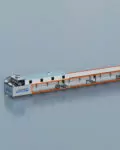For products like resins, waxes, oleo chemicals, black chemicals, sulphur, and several other chemical products many types of equipment can be used in the production line to help achieve your desired goal. These materials range from low to high viscosity and have melting temperatures up to 250 °C | 482 °F.
A wide range of chemical end products
End products that can be produced with Berndorf Band Group’s Cooling and Solidification Systems equipped with Steel Belts include:
Oleo Chemical Products: Oleo chemicals are utilized in various industries, including the production of baked goods, cosmetics, pharmaceuticals, industrial basic chemicals, and the energy sector. Key products include:
- Fatty acids
- Fatty alcohols
- Amines
- Amides
- Ester
- Stearines
- Polyethylene glycols (PEG)
- Surfactants (detergents)
- Others
Black Chemical Products: These are dark-colored, viscous substances derived mainly from the distillation of fossil fuels, particularly crude oil. They are primarily used in construction, road surfacing, and waterproofing applications. Here are examples of black chemicals produced on Berndorf Band Group Cooling and Solidification Systems:
- Bitumen
- Pitch
- Asphaltene
- Tar
- Others
Other Chemical Products: These are a diverse range of substances used in various industrial applications, from water treatment to adhesives and coatings. They are crucial for numerous manufacturing processes and contribute significantly to the efficiency and quality of end products. The following chemicals can be manufactured utilizing Berndorf Band Group’s equipment:
- Aluminium Sulphate
- Adhesives
- Hot melts
- Others
Berndorf Band Group recommends a variety of mechanisms to meet the strict and special manufacturing requirements. To learn what can work best for your product, contact us here!
Feeding Devices to produce Pastilles
A pastille is a split-pea shaped product that is created when liquid material is dropped onto a cooling platform and given time to solidify. Berndorf Band Groups pastillators are manufactured to ensure the uniform shape and size of each pastille as the product is pumped through the inner chamber of the feeding device, through a rotating shell, and onto the cooling Steel Belt.
BernDrop with raised shell – Pastillator*
The BernDrop® AD200 Pastillator is designed with a raised shell that doesn‘t require a refeed bar, leading to fewer parts that need maintenance. This special design works well for products with low to medium viscosity. Because there is no need for a refeed bar, the BernDrop® AD200 can run at higher speeds, possibly increasing production. As an added feature, the BernDrop® AD200 can also operate with a smooth shell and refeed bar, expanding its production capabilities to accommodate a wider range of products.
BernDrop® with smooth shell and reefed bar – Pastillator*
BernDrop® EF200 and the BernDrop® AD300 are Pastillators equipped with a smooth perforated shell and a refeed bar. This setup is particularly beneficial for products that tend to accumulate on the outer surface. The heated refeed bar efficiently gathers any excess material and redistributes it into the holes of the shell. As an additional feature, we provide a swivel mechanism for effortless pastillator maintenance, along with enhanced safety measures to prevent Steel Belt damage.
*also known as pelletizer or granulator












